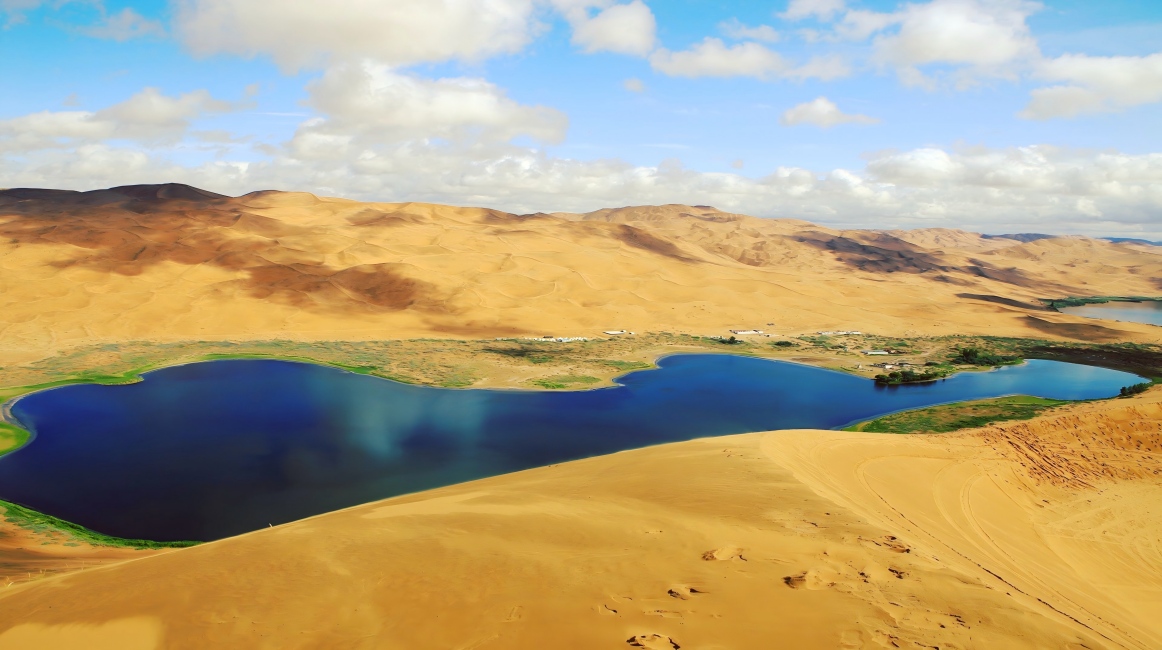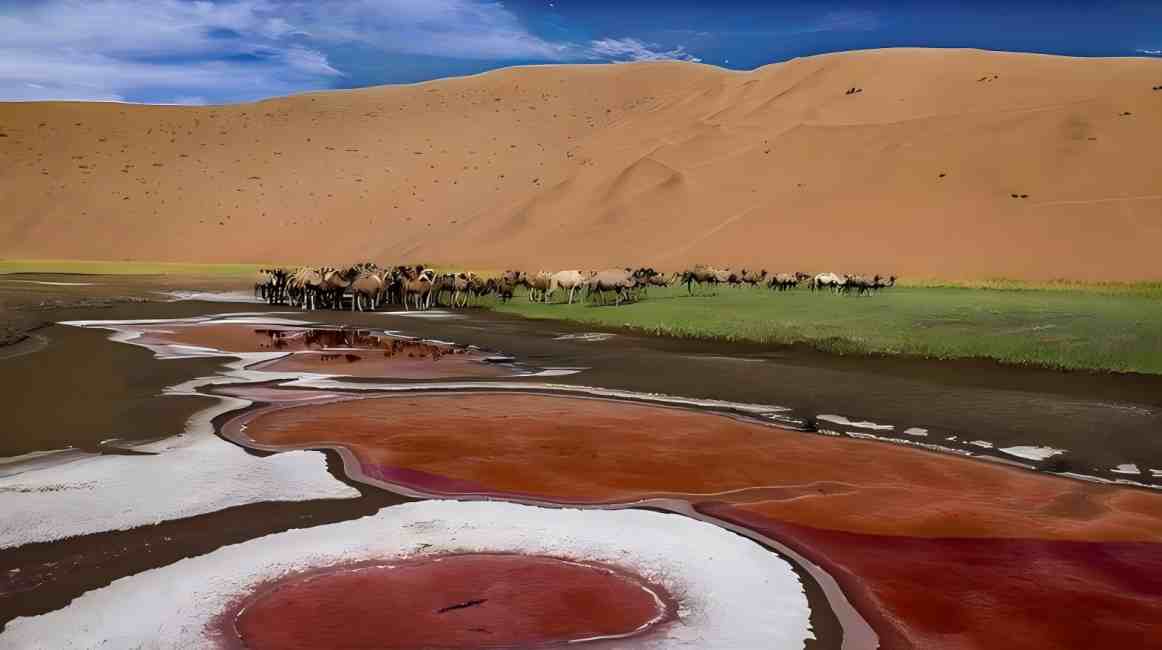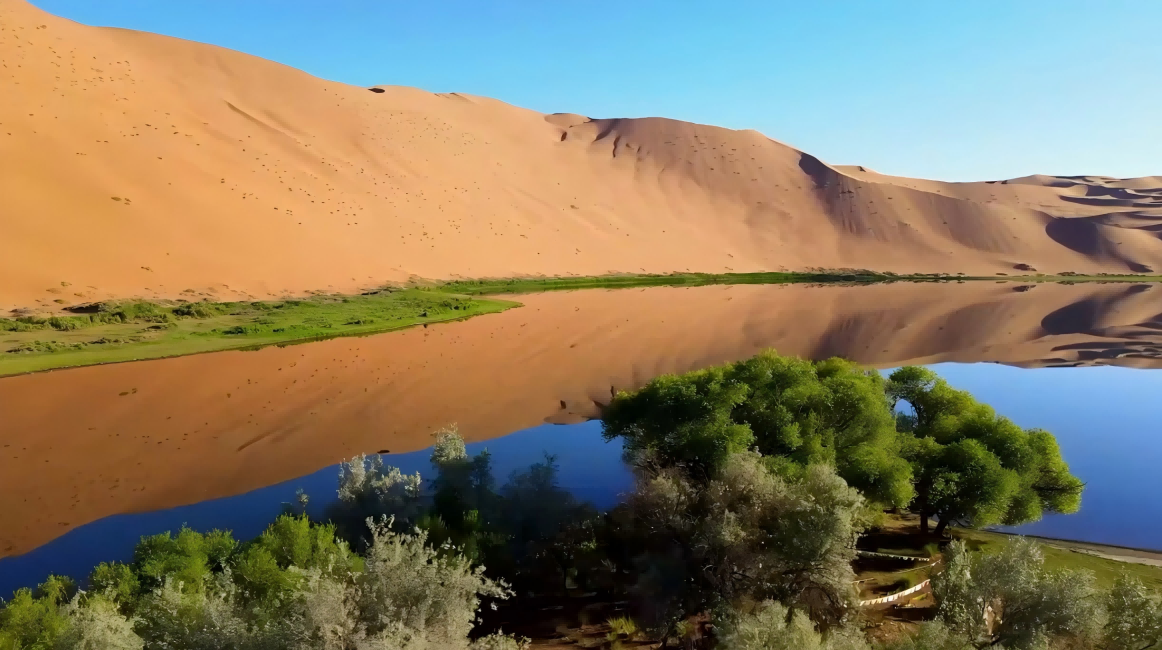The Badain Jaran Desert is located in the northern part of Alxa Right Banner, Inner Mongolia Autonomous Region, China, covering a total area of approximately 47,000 square kilometers. It is the third-largest desert in China and the fourth-largest in the world. Situated in the hinterland of Eurasia, the desert features a typical temperate continental climate with an annual precipitation of only 40-80 millimeters and an evaporation capacity exceeding 3,000 millimeters. The extremely arid environment has shaped its unique pattern of "endless sand dunes and scattered lakes." The core area of the desert is dominated by tall sand dunes, accounting for 61% of the total area, while the rest consists of gobi, salt marshes, and lake wetlands. With an altitude ranging from 1,200 to 1,600 meters, the terrain slopes from west to east, presenting a landform framework of "surrounded by mountains and elevated in the middle."

The core landscape of Badain Jaran is the "sand dune-lake" symbiotic system, a marvel in the desert. It boasts the world's tallest complex dune chains, among which Bilutu Peak stands at an altitude of 1,617 meters with a relative height of over 500 meters, known as the "Desert Everest." The sand dunes exhibit diverse forms—some towering like pyramids, others winding like crescent moons, forming smooth arcs under the influence of wind. More surprisingly, over 140 lakes of varying sizes are distributed in the hinterland of the desert, covering a total area of more than 23 square kilometers, forming the rare spectacle of "a thousand lakes in the desert." The blue-green lakes are inlaid in the golden sand sea, with reeds growing and waterbirds inhabiting along the shores, creating a striking contrast with the surrounding arid desert and presenting a visual feast of "sand and water coexisting, dynamic and static interacting." In addition, the singing sand dunes in the desert are a natural wonder—when strong winds sweep across the sand surface, they produce sounds like the rumble of war drums and the melody of orchestras, earning the desert the title of "the Kingdom of Singing Sand in the World."
The geological evolution of Badain Jaran is a microcosm of the formation of landforms in arid regions of the Earth. The basement of the desert is composed of Paleozoic granite and Mesozoic sandstone. Since the Cenozoic Era, crustal uplift, wind erosion, and accumulation have jointly shaped the current landform. Over the past 1 million years, strong winds brought by cold air from Siberia have transported sand grains from the surrounding gobi here, forming tall sand dunes through long-term accumulation. Meanwhile, groundwater recharge from deep fault zones has enabled depressions between sand dunes to form stable lakes, constructing a dynamic balance system of "groundwater level - sand dune height - lake distribution." Geological relics such as wind-eroded mushrooms, yardang landforms, and salt crystal landforms can also be seen in the desert. Especially the travertine deposits and gypsum crystals around the lakes record the traces of paleoclimate changes and hydrological evolution, serving as natural specimens for studying geological processes in arid regions.

Despite the extreme environment, Badain Jaran remains an important ecological gene pool. The desert vegetation is dominated by drought-tolerant and salt-tolerant shrubs and herbs, such as Haloxylon ammodendron, Hippophae rhamnoides, and Artemisia desertorum, forming sparse but stable desert vegetation communities that provide habitats for animals. It is home to national key protected animals such as Mongolian wild asses, goitered gazelles, and argali sheep. The lake wetlands are important stopover sites for migratory birds, where rare birds such as hooded cranes, black storks, and relic gulls breed or rest during migration. In the lake ecosystems, there are also endemic organisms adapted to high-salt environments, such as brine shrimp and Dunaliella salina, forming unique "extreme environment biological communities." Through long-term evolution, these organisms have developed survival strategies of water conservation, heat resistance, and salt tolerance, making Badain Jaran a key area for biodiversity conservation in global arid regions.
The Badain Jaran Desert holds irreplaceable scientific research value in fields such as geology, ecology, and climatology. Geologically, its "sand dune-lake" symbiotic system is an ideal sample for studying the relationship between wind accumulation, groundwater recharge, and landform evolution, providing key data for revealing the formation mechanism of landforms in arid regions. Ecologically, research on the adaptability of organisms in extreme environments offers important reference for biodiversity conservation under the background of global climate change. Climatologically, as one of the important sources of Asian sandstorms, studies on the sand transport process and its connection with global atmospheric circulation provide basic data for climate model construction. In addition, paleolake sediments and peat layers in the desert record climate change information over the past tens of thousands of years, serving as "natural archives" for reconstructing paleoclimates in arid regions.

As a world natural heritage, the protection and development of Badain Jaran have always adhered to the principle of "protection first, rational utilization." At present, the core area of the desert has been included in the Badain Jaran National Nature Reserve, with strict ecological protection measures implemented: overgrazing, unregulated mining, and destructive tourism activities are prohibited, and ecological monitoring stations have been established to conduct regular monitoring of sand dunes, lakes, and biodiversity. In terms of development, relying on its unique natural landscape, ecological tourism has been developed, creating characteristic tourism products such as "desert adventure, popular science research, and folk custom experience," which not only drive the income increase of local herdsmen but also spread the concept of ecological protection through tourism activities. Meanwhile, scientific research institutions cooperate with local governments to carry out ecological projects such as desertification control and groundwater protection, maintaining the stability of the desert ecosystem through measures such as planting sand-fixing plants and restoring wetland vegetation, and realizing a virtuous cycle of ecological protection and economic development.
The Badain Jaran Desert is not only a natural wonder but also a spiritual home with profound cultural connotations. It has been the traditional nomadic land of the Alxa Mongolian tribe. For generations, herdsmen have coexisted with the desert, forming a unique nomadic culture—they respect nature, worship heaven and earth, and have created production and living methods adapted to the desert environment, such as camel breeding and Artemisia desertorum collection. Their folk customs, song and dance art, and folk legends all reflect their love and awe for the desert. In addition, ancient post stations, rock paintings, and ruins in the desert witness the commercial exchanges and cultural communication of the ancient Silk Road, serving as historical marks of the integration of Eastern and Western civilizations. Today, the magnificent landscape of Badain Jaran has also become an inspiration for literary and artistic creation, attracting countless creators to explore the secret land of the sand sea and convey the concept of harmonious coexistence between humans and nature. Its cultural value has transcended regional boundaries and become a common spiritual wealth of all humanity.



